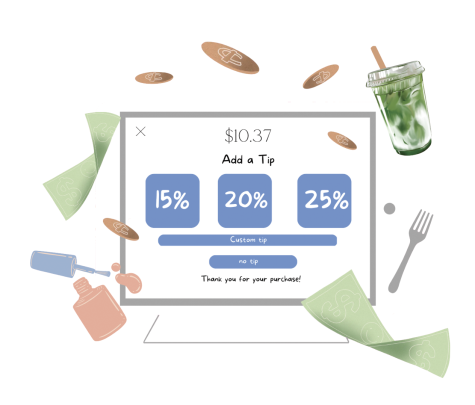To Tip or Not To Tip
As technology continues to advance the meaning and purpose of gratuity has transformed.
June 5, 2023
It’s the 21st century, and the turn of an iPad causes you to perspire like the condensation forming on your $5.35 iced matcha latte.
Three blue buttons pop up on the iPad screen, prodding you to press a tip percentage before you can un-awkwardly leave the coffee shop with your drink in hand.

Your options are 15%, 20%, or 25%. Initially, you decide to choose the middlebox, 20%, rounding the total cost for one beverage to $6.42.
Soon after, you begin to see the same iPad prompt at every smoothie place and restaurant in place of the classic glass jar, full of crinkled bills and the tinkle of loose change sitting at the bottom.
As a Laguna student says, “Tipping is difficult. I often battle between tipping a lot or being aware of how much I am already spending. I tip more when they go out of their way to make me feel special or just brighten my day.”
It’s becoming more apparent that we’ve met a tipping point where the max capacity for gratuities might be too gratuitous.
In his Atlantic article “Tipping Is Weird Now” journalist Charlie Warzel says that tipping has “gotten pretty weird.”
Collins Dictionary definition, the noun tipping refers to the act of leaving a gratuity (an amount of money) “to someone who has provided a service.”
Most commonly instituted in the hospitality industry in America, a precedent to not only tip but to tip well, regardless of the service, has been set.
Statistics provided by PlayUSA suggest 1 in 3 Americans tip no matter if the service quality is good or bad, leaving people confused and frustrated over the service industry’s exemption from paying staff a sustainable minimum wage.
Corporations such as restaurants and hotels have built an assumption that employees are being compensated for their minimum wage by the tips received for their gratuity, which will inherently make up or exceed their base salary.
While across the counter, customers believe that the insurgence of tipping rates begs for fairer wages exposing the deeper-rooted issues in America’s tipping culture.
On the contrary, in the eyes of several countries in Europe and Asia, tipping is not expected as it is deemed impolite today, given the origins of tipping derived from bribes.
However, in the early 1850s and 1860s, when wealthy Americans traveled to Europe and saw them reward their workers for their exceptional work, the Americans brought the concept of tipping back home to feel aristocratic.
Coining the moniker, guilty-tipping by the New York Post, the pressure to tip everywhere has gotten out of hand, becoming a social norm depleting the original intent and value behind giving gratuity for good service.
In light of the pandemic, businesses sought to provide extra support for employees at the height of COVID by adopting digital tipping methods that automatically have preset amounts for gratuity.
Experts say the amounts of gratuity rose significantly in support of businesses during COVID, based on Forbes’ 2023 Digital Tipping Survey reporting that “65% of people tip at least 10% more when they tip digitally versus with cash.” With thousands of users across America in all business spaces, Square has become one of the leading operating digital payment companies alongside Clover and Toast.
However, given such positive outcomes, even after businesses have transitioned back to normality, high tipping rates still remain.
In general, consumers have taken great pride in leaving a gratuity for waiters at a restaurant or a salon when asked to tip an automated kiosk at Starbucks, the idea of a customary tip might seem far-fetched.
Yet you don’t want to seem like a cheapskate.
Unlike traditional tip jars, which customers can disregard if they don’t have an extra change, iPads with digital requests are way harder to bypass, creating social pressure.
However, the significance of a tip to hardworking employees who may rely on that income for their livelihood is essential.
After managers and owners have attempted to avoid providing their workers with adequate and sustainable wages for decades, employees are left on the back burner. So just how much longer can America go, until it meets its tipping point?

































